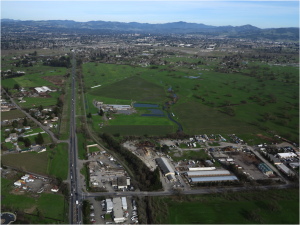An application, including the Dairyman Winery/Distillery project goes through a series of steps before it gets to a public hearing such as the Planning Commission (PC) or the Board of Zoning Adjustment (BZA), and/or the Board of Supervisors. Below are some of the steps, coded:
Italics text = completed step
Bold text = current status
Regular text = next series of steps
- An application is determined to be complete when all the requirements in terms of description and basic studies / information are submitted to the Permit and Resource Management Department of Sonoma County (PRMD).
- When the application is deemed complete, PRMD sends a referral requesting a response to a number of responsible Agencies (examples: Caltrans, Fish & Wildlife, Water Quality Control Board, etc) and/or other jurisdictions/districts (school, water, cities, etc). The project description is included in this referral and the responders are asked to comment on any issues they have within a time limit.
- After responses are received by PRMD, staff analyzes the issues raised and determines the necessary next steps. If the analysis or responses do not rise to a level of requiring an Environmental Impact Report (EIR), staff will proceed with a Mitigated Negative Declaration (MND, or Neg Dec for short) which will describe, including a MND check list, the level of impact the project is determined to have in each of the noted areas (traffic, air quality, noise, etc) and how, if necessary, they are mitigated. Basically, this is a statement that all impacts have been mitigated (addressed) to a level of acceptability. (it “Declares” that “Mitigations” are adequate)
- If a MND is used, a public hearing will be held before the decision making body when citizens and the applicant (sometimes with their experts) are invited to speak on the project. The governing body may then approve, deny, or ask for additional studies, and possibly an EIR. The citizens or the applicant may appeal a PC or BZA decision to the Board of Supervisors.
- After examination, if it is determined that there are impacts that cannot be adequately mitigated/addressed, an EIR may be required. An EIR may be required any time along the process: staff, the PC/BZA or the Board of Supervisors may require one. The applicant will hire experts specializing in the areas required to be studied. An EIR analysis is done to disclose impacts in order to mitigate them (address them) to a level of insignificance. If this level cannot be met, sometimes a Declaration of Overriding Considerations may be issued by the decision makers. This could include some public value, such as parkland, public trails dedication, or other benefits that must be named.
A scoping session will be held to allow citizens to have input on the issues that should be studied in the impact analysis. Preparing the EIR, the specialized consultants research and author reports to be included in the Draft Environmental Impact Report, including various scenarios (alternative analysis) and mitigations.
- A public hearing is held in order for citizens to comment on the adequacy of the Draft EIR. The applicant’s consultants must address the comments made at this hearing or before in the next phase of the EIR.
- The final EIR will hold the original studies, impact analysis, mitigations, alternatives and responses to the comments, and another series of hearings will be held with public comment opportunities.
- The project proposal with the EIR will proceed through the review process, including hearing/s before the PC/BZA and the Board of Supervisors. If one of the parties (the citizens or the applicant) disagrees with the Board of Supervisors ruling, they may file a lawsuit at this time.
